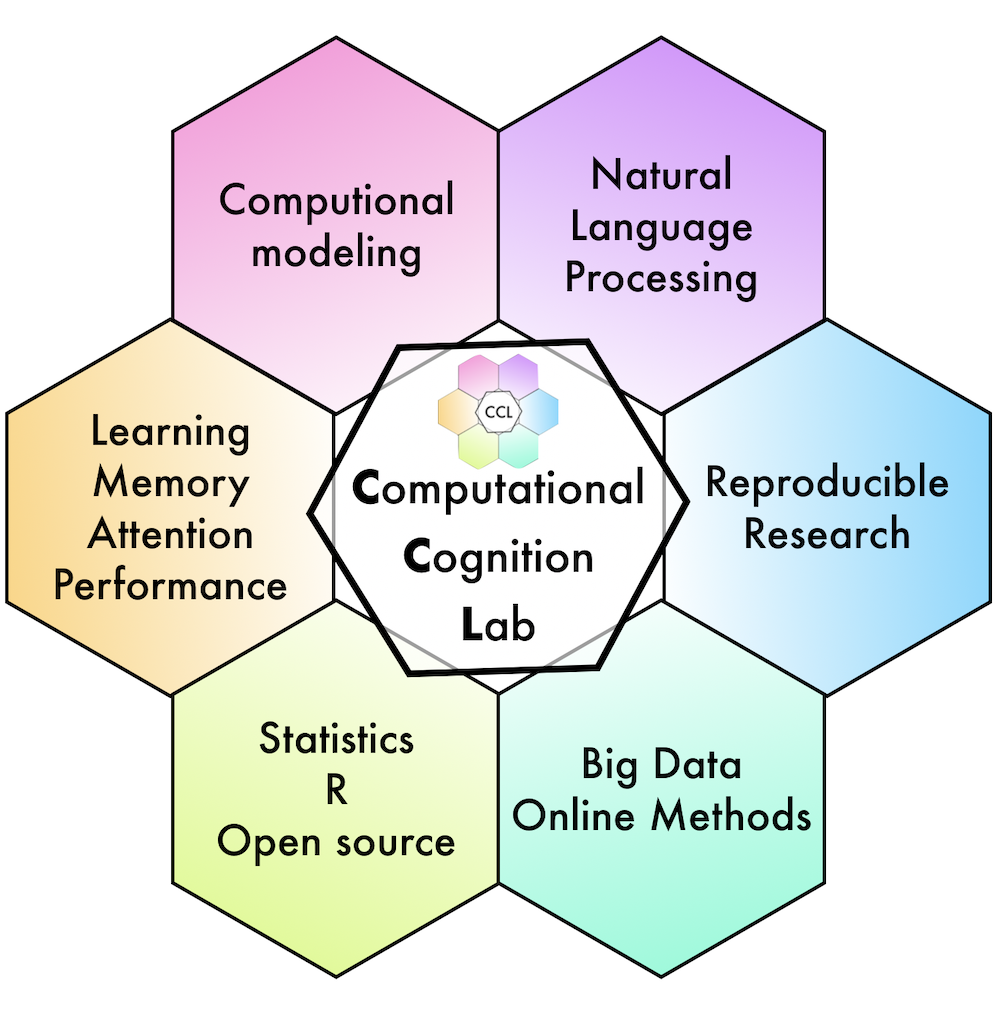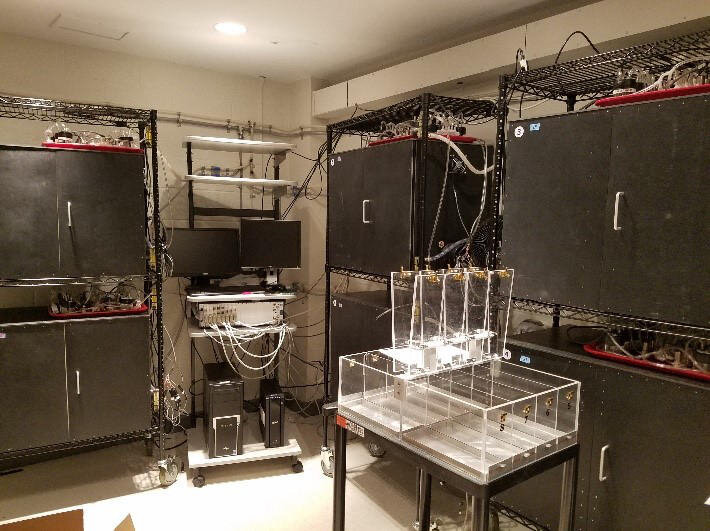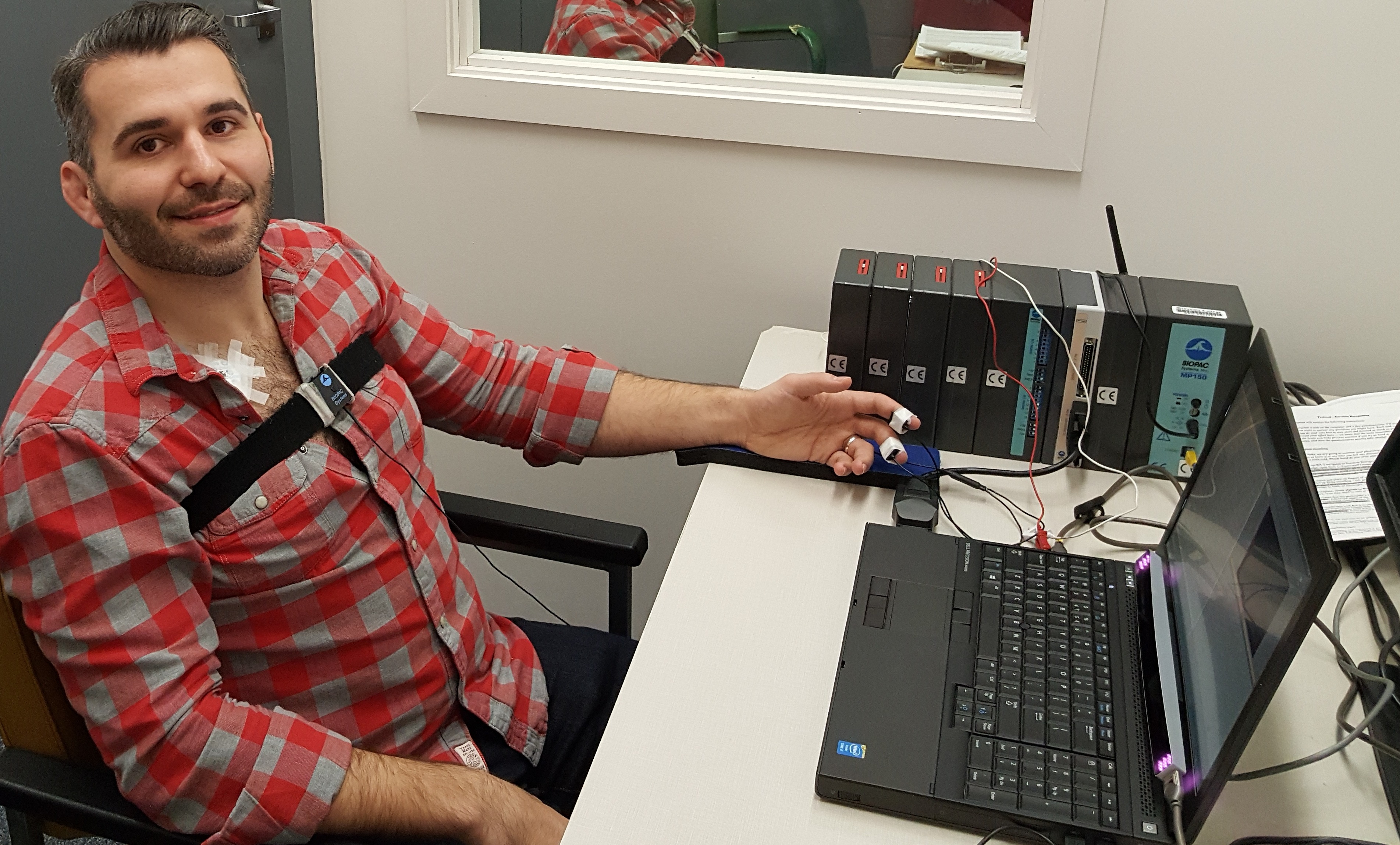Research
More than a dozen active laboratories in the department focus on topics such as the physiology of taste and preference formation, children's acquisition of spatial knowledge, transactive knowledge in organizations, implicit learning in cognitive disorders, visual functions in Down syndrome, creativity and cognition in the arts, cognition without a spine (i.e., in octopus), hippocampal atrophy in early Alzheimer's disease, implicit impression formation, Darwinian models of mate selection, biomemetic robotics, neurodegeneration in the aged and implicit social cognition.
All labs are well equipped, and many have attracted funding from NSF, NIH, NASA, DARPA, and other organizations. Several faculty members have appointments and working collaborations with research labs in city hospitals and medical schools with access to frontier technologies such as fMRI.
Sign Up for Research Participation
Undergraduate students who are currently taking the Introduction to Psychology course may sign up for research participation.
Faculty Research Specializations
Israel Abramov
Visual psychophysics, color vision, spatial vision, visual neuroscience
We study vision – all aspects of vision, in any accessible creature. We have used techniques ranging from anatomy, to electrophysiology, to behavioral methods. We have studied topics from recording responses of single neurons to spectral lights, to impact of environmental light on aesthetics of museum-going, to sex-linked differences in basic visual functions, to categorization of objects seen under degraded viewing conditions. Always, our approach is ultimately based on the biology of the visual system. These studies derive from a program we undertook some three decades ago: creation of a battery of tests to measure many aspects of vision: spatial and temporal resolution, and acuity; color vision, from discrimination to magnitude estimation of color appearance; binocular vision, stereopsis, and stereo-acuity; motion detection; pigmentation of iris and skin. At present we are concentrating on behavioral (a.k.a. psychophysical) studies of sex-linked variations in vision, and detectability of objects when viewing is less than optimal.
Website: Isreal Abramov, Ph.D.

Elisabeth Brauner
organizational psychology, transactive memory, organizational communication
The Organizational Psychology Lab studies the relations among cognition, communication, and social structures within organizations. We have focused on transactive memory, communicative processes of knowledge acquisition, and how this can be applied to knowledge management and organizational learning. We have developed methods for investigating transactive knowledge and knowledge transfer using both questionnaires and interaction coding systems. We also conduct applied research that helps organizations with problem analysis and problem solving. Currently, we are working on organizational diagnosis for information transfer processes.
Website: Elisabeth Brauner, Dr. rer. nat.
Cheryl Carmichael
close relationships, emotion regulation, health, perceived responsiveness, romantic attachment
The Health, Emotions, and Relationships Team (HEaRT) Lab conducts research aimed at discovering why people with stronger social connections live longer, happier, healthier lives. We examine how personal characteristics (e.g., attachment security) and responsive relationship behaviors (e.g., support provision, physical contact) promote relationship quality, health, and well-being. Our research participants include college students, community couples, and online workers. We collect self-report, behavioral, and psychophysiological measures using a combination of experimental and experience sampling approaches to study relationships processes in the laboratory and in the ebb and flow of day to day life.
Website: http://bcheartlab.com/
.jpg)
Elizabeth Chua
metamemory, memory, metacognition, neuroimaging, eye tracking, brain stimulation
Elizabeth Chua’s main interests are in cognitive, affective and neural bases of metacognition and memory. The lab mainly focuses on people’s knowledge and awareness of their own memory, and how this impacts their behavior. The methods currently used to answer questions on these topics include behavioral, eye tracking, psychophysiological, and brain stimulation techniques.
Website: http://userhome.brooklyn.cuny.edu/echua/

Matthew Crump
computational modeling, skill-learning, memory, attention, natural-language processing, pattern-recognition and production
Crump runs the Computational Cognition Lab at Brooklyn College of CUNY. Research interests include learning, memory, attention, performance, and semantic cognition. Some questions include how do people learn new skills like playing an instrument or typing on a keyboard? How does memory work? How do people learn the meaning of words? How do people learn patterns and regularities in their environment? These kinds of questions are investigated using behavioral experiments and computational modeling of cognitive processes. The lab also uses a variety of computational methods and tools to conduct and communicate research. Students interested in cognition, computation, and data-analysis are encouraged to visit the lab website to inquire about research opportunities.
Website: https://crumplab.github.io/
.jpg)
Andrew Delamater
associative learning, reward processing, interval timing, Pavlovian extinction learning, cortico-striato-limbic pathways in associative learning, relational learning processes, prediction error mechanisms, connectionist network models
The Delamater lab explores the psychological and neurobiological mechanisms involved in simple forms of associative learning mostly in rodent models. We use a variety of behavioral and behavioral neuroscience techniques including (a) targeted brain structure lesions, (b) pharmacological inactivation, (c) chemogenetic manipulations using DREADDs, (d) immunohistochemistry labeling (e.g., cFos), and (e) sophisticated behavioral tests. One project investigates the nature of reward processing where we focus on the question of how the brain learns to anticipate “what” reward is likely to occur in the near future as well as precisely “when” it will occur. We ask whether these two aspects of learning engage separate underlying neural systems, and we also ask to what extent “prediction errors” along these different “what” and “when” dimensions might be critical for brain plasticity. Another project explores the nature of the associative network that could give rise to the ability to time future rewards. To explore this we have devised a neural net model that is capable of showing temporally organized behavior as well as various phenomena related to interval timing. A third project examines the nature of extinction learning in Pavlovian conditioning. In particular, we ask what conditions might be especially helpful in promoting response loss after learning has taken place. Here, as well, we attempt to dissect learning into its separate components (sensory, temporal, emotional) and ask whether extinction processes might differentially impact these different forms of learning. Additional projects address other aspects of associative learning including (a) learning about higher order conditional relationships among stimuli, and (b) assessing striatal contributions to goal-directed and habitual control of associatively learned instrumental behaviors. Some specific projects involve assessing cortico-striato-limbic pathways for their role in reward encoding, with special emphases on reward identity and reward timing processes.
Website: http://academic.brooklyn.cuny.edu/psych/delam/
Jennifer Drake
emotion regulation benefits of drawing; drawing giftedness; visual thinking; aesthetic judgment
My research program focuses on the psychology of the visual arts. In one line of research, I examine the emotion regulation benefits of engaging in drawing for children and adults. I have shown that drawing improves mood by allowing for distraction rather than expression. My current work delves deeper and more systematically into the question of how drawing to distract elevates mood. In a second line of research, I examine variation in drawing ability, asking what underlying abilities are seen in children who show exceptional graphic realism skill at a very young age. I have found that drawing prodigies and precocious realists have superior perceptual skills. Finally, I study children’s and adult’s responses to and understanding of works of visual art.
Website: www.jenniferdrake.com
Paul Forlano
Using fish as model systems
Paul Forlano’s lab employs a combination of evolutionary/systems neuroscience with a cellular and molecular approach in order to identify neurochemical interactions in circuitry underlying auditory-driven social behavior, mechanisms of steroid-induced neural plasticity, and sex differences in brain and behavior. These studies largely focus on vocal, auditory and neuroendocrine circuits that are conserved across vertebrates.

William Esber
Our lab investigates the neural substrates of associative learning at the systems neuroscience level. We focus on associative learning processes because they form the building blocks of cognition, and provide us with an analytically tractable tool to study all sorts of interesting topics, from craving to categorization. Our overarching questions are how neuronal circuits encode information during learning and how this information later influences decision-making.
Website: William Esber, Ph.D.
Ana Gantman
morality, moralization, consent, intentionality, visual perception, attention, audition
The Gantman Lab investigate the process of moralization (when preferences become values) and its consequences for behavior, cognition, and perception. Our research investigates how context, rather than content, determines moral relevance and so we emphasize and explore the context-dependence of moral relevance, and we investigate both the processes that underlie moralization, and its applications to social issues. We use a number of different methods ranging from techniques from vision sciences and cognitive psychology, to surveys, classic social psychology lab experiments and field work. We are committed to research that is theoretically rich and pragmatically useful. We bear in mind, Lewin’s idea that “There is nothing so practical as a good theory” and James’ notion that we study the “rich thicket of reality.”
Website: www.anagantman.com

Yu Gao
.
Our research focuses on the neurobiological and psychosocial bases of antisocial behavior, psychopathic, and autistic traits in youth and adults. We are particularly interested in identifying early risk factors that may predispose youth to antisocial behavior, and the protective factors that can buffer young people from the risks of becoming antisocial. One line of research focuses on conditioning deficits in individuals with aggressive and antisocial behavior. We also examine emotion dysregulation and reward processing abnormalities in youths with behavioral problems. We use multi-modal methods from longitudinal and cross-sectional perspectives. The psychophysiological methods we use include electrodermal activity (EDA), cardiovascular activity such as heart rate (HR), heart rate variability (HRV)/respiratory sinus arrhythmia (RSA), and pre-ejection period (PEP). We also use structural and functional brain imaging (sMRI and fMRI).
Website: The Psychophysiology Lab
Stefano Ghirlanda
learning, animal behavior, cultural evolution
I study how animals and people learn, including learning and evolution of traditions and culture. I conduct experiments on human learning and I build computational models of learning and cultural evolution. I accept undergraduate and graduate students, especially if interested in computational modeling.
Website: Stefano Ghirlanda, Ph.D.
Curtis Hardin
Website: Curtis Hardin, Ph.D.

Aaron Kozbelt
creativity, psychology of the arts, humor
My research focuses on creativity and the psychology of the arts. I use laboratory, survey, and archival methods to study questions like perceptual differences between artists and non-artists, how creativity unfolds over the lifespan in classical composers, how artists dynamically evaluate emerging creative products, the psychology of humor production, and possible evolutionary constraints on human psychological aesthetics.
Website: Aaron Kozbelt, Ph.D.
Yana Kuchirko
Developmental psychology, cross-cultural development, language development, socio-economic differences in development, naturalistic research methods
My research focuses on the role of culture and context in child development. Specifically, I examine how socioeconomic context shapes young children’s cognitive development, how children’s everyday interactions vary by cultural context, and how settings (e.g., childcare, school, neighborhoods) shape children’s learning trajectories. To answer these questions, my students and I use a combination of survey, interview, and observational methods to capture daily experiences of children and their families from different ethnic, racial, and socioeconomic backgrounds.
Website: https://www.culturelabbc.com/
Daniel Kurylo
Cognitive Neuroscience; perceptual impairment in clinical populations; visual system; visual perception
My research focuses on how information is integrated across areas of the brain. This topic is addressed by studying characteristics of perceptual organization in healthy individuals, clinical populations (including individuals with brain injury or schizophrenia), and in an animal model. Members of the lab gain experience with techniques used to measure perceptual abilities, developing neuropsychological assessment for clinical groups, and applying these techniques to assess perception in animal models.
Website: Daniel Kurylo, Ph.D.
Laura Rabin
Cognitive, Neuroscience, Testing, Methods and Measurements, Philosophical Psychology
My research investigates cognitive and neurophysiological changes associated with symptomatic prodromal stages of dementia, toward identification of the earliest markers of dementia risk. I also study changes in judgment and problem solving along the Alzheimer’s disease continuum with implications for preventing exploitation, unsafe behaviors, and functional dependence among those most vulnerable. To carry out this work, I utilize neuropsychological tests, self- and informant-report questionnaires, genetic testing, and neuroimaging (structural and functional MRI). In addition, a line of educational research focuses on understanding factors that impact undergraduate student performance and improving academic and mental health outcomes of diverse students.
Website: Laura Rabin, Ph.D.
Jacob Shane
Lifespan development; motivation, goal selection and pursuit; perceived opportunities and constraints.
My research examines how motivation and opportunity direct and reflect individuals' development across the life span. I am particularly interested in the dynamic relationships between individuals' broader beliefs about society, their beliefs about themselves, and their motivational commitment to central life goals.
Website: Jacob Shane, Ph.D.
Maria Torrente
Neurodegenerative diseases are incurable illnesses that are linked to the death of nerve cells.
The Torrente lab studies the changes in gene organization that occur in neurodegenerative disease. Genes spool around proteins called histones, which have tails that contain modifications that regulate access to genetic information. Because these modifications can be targeted with pharmaceuticals, our research opens avenues for new treatments.
Deborah Walder
neurodevelopment, neurocognition, stress, mental health risk, psychosis, schizotypy, depression
Our research emphasizes identification of early neurodevelopmental markers of risk for mental health disorders such as psychosis and depression, and the contributory role of other factors such as stress and sex/gender differences. We study biomarkers of risk (using neurohormone assay, neuropsychological testing, brain imaging techniques) and environmental factors (such as stress) among high-risk youth, young adults at psychometric risk, and healthy individuals from the general population. This includes use of prospective methods to better understand the early trajectory of illness, with an eye toward preventive intervention.
Website: Deborah Walder, Ph.D.
Affiliated Faculty
Paul Forlano
Maria Torrente






